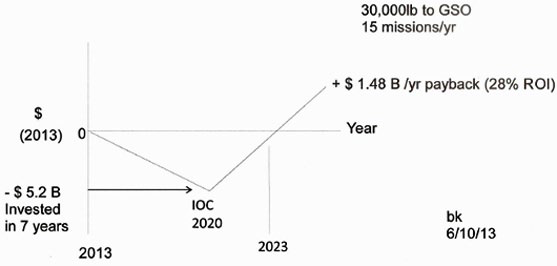
This article will introduce readers to a proposed new concept for delivering payloads/satellites to geosynchronous orbit (GSO) that weigh twice as much—and cost half as much—to launch than with expendable launch vehicles, and to service and refuel satellites on- orbit, and to conduct other missions not currently possible.
Background
There are approximately 300 satellites (communications, navigation, weather, NASA, military, and so on) in GSO, with projections to add new ones to replace aging old ones already in orbit.
The global telecommunications industry alone generates revenues of more than 160 billion dollars annually with a growth of more than 10 percent per year, and represents a total investment of more than US$4 trillion, according to the Satellite Industry Association (SIA). These satellites cost several hundred million dollars each.
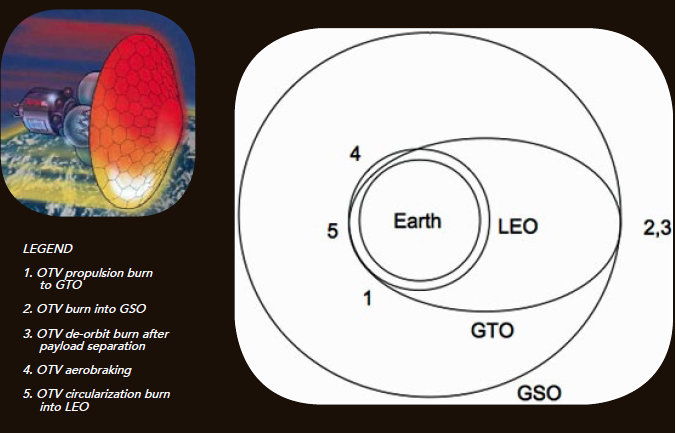
Current costs to launch these satellites to Geostationary Transfer Orbit (GTO) using expendable launch vehicles adds another several hundred million dollars to each mission. Several companies (United Launch Alliance, Arianespace, MHI, Space-X, etc.) are hoping to develop the capability to launch heavier satellites to GTO at lower cost by improving on their current expendable launch vehicles (ELVs), such as Atlas V, Ariane 5, H-2A, Falcon 9, and others.
Another approach presented herein is to consider introduction of a reusable space-based orbit transfer vehicle (OTV) to further reduce cost and increase payload weight, and to provide other benefits not possible with expendable systems. The space-based OTV is an evolution of current expendable cryogenic upper stages (such as Centaur) which are currently launched on ELVs (Atlas V, Delta IV, Ariane 5, H-2A, etc.). Each of these high energy upper stages using cryogenic propellants (oxygen/hydrogen) are currently used to transfer payloads/satellites to low earth orbit (LEO) and beyond.
These vehicles are in a different class than current resupply vehicles to the International Space Station (ISS), such as the European ATV, the Russian Progress, the Japanese HTV, the Space-X Dragon, and the Orbital Sciences Corp (OSC) Cygnus, each of which have only a limited capability to operate at LEO.
Solar electric Ion propulsion systems for transferring satellites into final orbits are quite efficient but are low in thrust. They can also require weeks to months to transfer payloads into position—such limits their usefulness for missions that require a much faster response time.
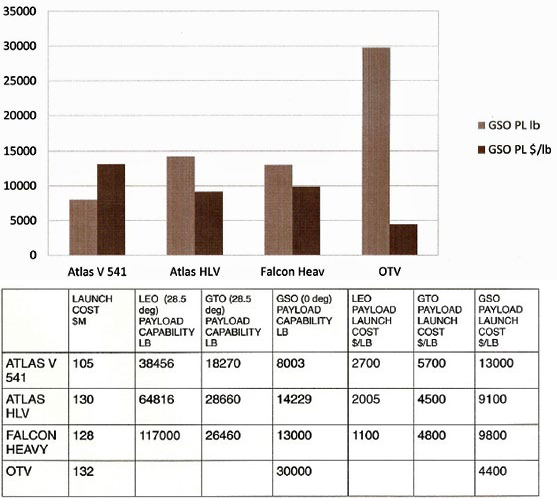
Note: All costs are estimates (except for Falcon Heavy, which is advertised by SpaceX) and do not include payload unique launch services (such as payload processing and integration, ground support and tracking, data and TM services, and so on). All Atlas and Falcon performance (payload) data is excerpted directly from their users manuals (ULA; SpaceX), except for Falcon Heavy GSO, which is estimated. Space-based OTV (SBOTV) data are estimates.
Space-Based OTV
Space-based OTVs offer significant potential economic advantages over ground-based expendable systems, cutting the launch cost in half and doubling the weight of payloads. This is possible because of reduction in Earth launch costs, higher performance vehicle designs, efficient reusable vehicle operations, and lower cost propellant availability.
These OTVs will be based at a LEO facility for servicing, maintenance, and refueling, either attached to the ISS or at a separate dedicated facility. Payloads, and propellants for the OTVs, will be delivered from the Earth’s surface to the LEO facility for integration with the OTVs by low cost expendable launch vehicles (i.e., Falcon Heavy) and future Reusable Launch Vehicles (RLVs).
In addition to launching new satellites, servicing and refueling of satellites already at GSO can be provided. This obviates the need for expensive replacement satellites in the event of a minor problem with an otherwise functional satellite. Satellites can also be retrieved and returned to LEO if necessary.
These OTVs can also be used to remove space debris and to capture and move space resources such as near earth objects (asteroids, etc.) to LEO for processing into useful products. Transport of astronauts/tourists from LEO to lunar orbit and return is also possible.
The potential for additional future space operations is expected as increased capabilities develop, such as the basing of a planetary transfer vehicle using advanced propulsion (nuclear) to reduce trip times to Mars and other planets. It is expected that this new capability will interest private sector investors, commercial communications satellite companies, space based solar power (SBSP) and space resource and manufacturing startups, space tourism providers, and others.
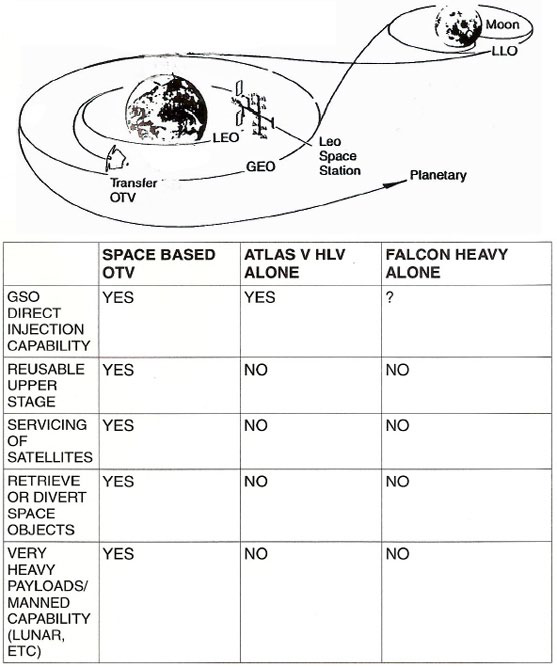
Aerospace companies such as Boeing, Lockheed- Martin, Arianespace, MHI, Space-X, Orbital Sciences, and other expendable launch vehicle companies, will also benefit from providing increased launch services to LEO.
Previous Studies
OTVs and orbital facilities previously studied in detail for NASA (references 1, 2 and 3), and current NASA research on propellant storage and transfer in space at the ISS, etc., bring us closer to achieving this capability. The prior study efforts compared many concepts in order to find the lowest cost and highest performing system for delivering space payloads to higher orbits beyond LEO. The clear advantage of a space based OTV was the result.
However, NASA elected not to proceed, and the idea was never disseminated to users who could have benefited. That is, until now.
There is currently renewed interest in moving beyond LEO to deliver new heavier satellites to GSO as well as accomplish other missions, such as servicing and refueling satellites, removing space debris, capturing and moving Near Earth Objects (NEOs), such as asteroids, to reduce the danger of Earth impact and to use them as resources for space manufacturing, sending astronauts/tourists to Lunar orbit and back, and more.
In the several decades since these studies were conducted, technology has advanced to such a point that development of the space-based OTV can be expected to proceed with confidence. Also, the ISS now exists, offering the possibility of attaching an OTV facility and increasing the utility and longevity of the ISS.
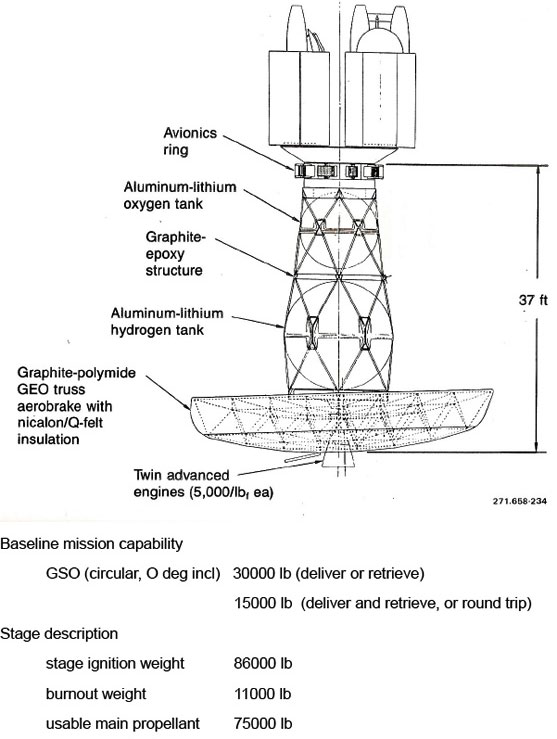
Technology Demonstration
As a first step, demonstration of one of the key technologies needed is aerobraking for the return of the OTV to LEO after mission completion. Aerobraking greatly reduces the OTV propellant requirement by taking advantage of aerodynamic drag to decrease the velocity to re-enter LEO, instead of using the main engines. Aerobraking has been successfully used on previous manned missions to LEO and to the Moon and for unmanned Mars landers. The addition of a new, deployable, geotruss aerobrake to an existing upper stage, such as Centaur, can be accomplished at no risk to the primary mission.
Once the primary mission of delivering a satellite to GTO (or GSO) is accomplished, the aerobrake is deployed (and the engines are restarted to de-orbit from GSO). When the Centaur reaches the upper atmosphere, the aerobrake retards the Centaur velocity to rendezvous at LEO with the ISS for capture and inspection (and potential reuse when the capability to refuel becomes available).
It is proposed that this demonstration be accomplished on an upcoming Atlas V satellite delivery mission. It should be noted that technology demonstrations using Centaur have previously been successfully conducted (to evaluate in-space cryogenic fluid management techniques) after separation of the primary payload satellite (ref. Atlas V AV-017, DMSP-18).
Conclusion
Space based OTVs offer the lowest cost for transferring heavier payloads from LEO to GSO, and also enable other missions not currently possible with expendable systems. The technology exists to proceed to construct the space infrastructure necessary to support orbital operations.
Challenges
Perhaps the biggest challenge is to first persuade that the idea of a space-based OTV infrastructure is going to be profitable and that the investment risk can be minimized.
In order to illustrate this a cost analysis has been conducted for a space-based OTV mission to deliver a payload from LEO (108 nautical miles altitude/28.5 degrees inclination) to GSO (19,323 nautical miles altitude/circular/zero degrees inclination).
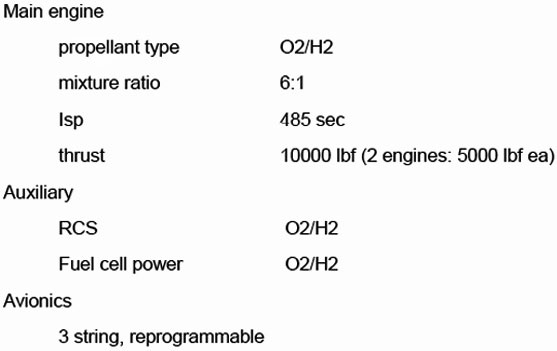
Reusable space-based OTV delivery of 30,000 lb. payload to GSO
- ◊ Falcon Heavy delivery of the payload (30,000 lb.), and propellant (75,000 lb..) for the reusable space-based OTV to LEO = $128 million
- ◊ Reusable space-based OTV payload integration and mission operations = $4 million
- ◊ Total mission cost = $132 million ($4,400/lb.)
- Development, production, and delivery of OTVs and the Accommodations Facility to LEO (from ref 1, 2, and 3, updated to 2013 $):
- ◊ Orbital Transfer Vehicles - $2.5 billion *
- ◊ Accommodations Facility - $2.7 billion *
Note: These numbers were based on using the Space Shuttle for delivery of the facility and OTVs to LEO. Lower costs would be expected from using lower cost launch vehicles, such as the Space-X Falcon Heavy launch vehicle. Assuming a 7 year development program leading to initial operational capability (IOC), this amounts to an investment of $743 million per year.
With the start of GSO operational missions in 2020, it is proposed to offer a 15 percent discount from ATLAS HLV (from $9,100/lb. to $7,700/lb.).
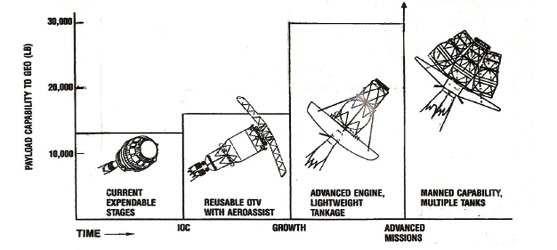
The space-based OTV evolves from an existing upper stage such as Centaur to the operational baseline. With as many as 6 additional tanksets for more propellant, increased mission capability is possible for heavier payloads and for manned missions.
With each OTV mission delivering 30,000 lb. into GSO at a price of $7,700/lb., and at a cost of $4,400/lb., this gives a profit of $99 million per mission.
Assuming 15 missions per year, then the $5.2 billion investment is recovered in 3-1/2 years, with a payback of $1.48 billion per year, an annual rate of return (ROI) of 28 percent.
References
- (1) “Orbital Transfer Vehicle Concept Definition and System Analysis Study”, GDSS-SP-86-011
- (2) “Turnaround Operations Analysis for OTV”, NAS8-36924
- (3) “Servicing and Maintaining a Lunar Transportation System in Low Earth Orbit”, LBS-88-138, W. Ketchum, J. Maloney, L. Pena, D. Saxton
- (4) “What will America do in Space now ?”, W.J. Ketchum
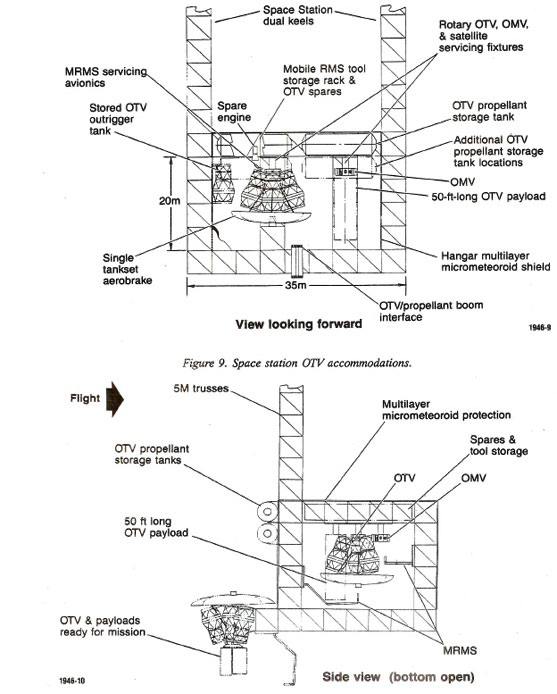
Accommodations for servicing OTVs
About the author
William Ketchum is an Associate Fellow of the American Institute of Aeronautics and Astronautics. He holds a Master of Science Degree in Aerospace Systems Management from the University of Southern California. He started his Aerospace career in 1956 at Edwards Air Force Base in Flight Test Engineering. He then worked for General Dynamics Space Systems Division, specializing in cryogenic liquid propellant rocket propulsion systems, developing the Atlas and Centaur space launch vehicles. He participated in designing the Fully Reusable Space Shuttle, Space-Based Orbit Transfer Vehicles, and Nuclear-Thermal rockets for human interplanetary missions. His military experience was in the U.S. Army Missile Command at Redstone Arsenal, testing the solid propellant Nike-Zeus Missile Defense System. His work is in Astronautics and Astrodynamics. He is a consultant for the next generation of Space Launch Systems and he is developing a small, reusable, personal spaceplane. He has written many technical reports and papers and lectured on the history of the space program at schools and public events nationwide. He lives in San Diego, California.
Note: Mr. Ketchum was the General Dynamics OTV study/program manager for NASA-MSFC three year, $2 million effort, which provided the basis for this article.
For further details, please visit: http://www.thespacetransfercompany.com/

